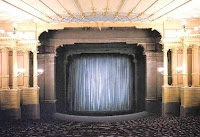 The plan was done by Wagner, without the architect's permission, from an unrealised project by Gottfried Semper for an opera house in Munich, and built under Wagner's supervision. Its construction was funded principally by King Ludwig II of Bavaria. The foundation stone was laid on 22 May 1872 which is Wagner's birthday. The building was first opened for the premiere of complete four-opera cycle of Der Ring des Nibelungen means The Ring of the Nibelung, from August 13, 1876 to August 17, 1876.
The plan was done by Wagner, without the architect's permission, from an unrealised project by Gottfried Semper for an opera house in Munich, and built under Wagner's supervision. Its construction was funded principally by King Ludwig II of Bavaria. The foundation stone was laid on 22 May 1872 which is Wagner's birthday. The building was first opened for the premiere of complete four-opera cycle of Der Ring des Nibelungen means The Ring of the Nibelung, from August 13, 1876 to August 17, 1876. Only the entry facade exhibits the typical late-19th-century decoration, while the remainder of the exterior is modest and shows mostly undecorated brick stone. The interior is mainly wood, which contributes to the excellent acoustics. Unlike the traditional opera house design with several tiers of seating in a horse-shoe shaped auditorium. The seats are arranged in a single steeply-shaped wedge, with no galleries or boxes and capacity is 1,925.
Only the entry facade exhibits the typical late-19th-century decoration, while the remainder of the exterior is modest and shows mostly undecorated brick stone. The interior is mainly wood, which contributes to the excellent acoustics. Unlike the traditional opera house design with several tiers of seating in a horse-shoe shaped auditorium. The seats are arranged in a single steeply-shaped wedge, with no galleries or boxes and capacity is 1,925.The most eminent and important aspect of the Festspielhaus is its extraordinary orchestra pit.
 It is recessed under the stage and covered by hood so that the orchestra is invisible to audience. This feature was concern for Wagner since it made the audience focus on drama onstage rather than the action of conductor and musicians. The design also corrected the stability of volume between singers and orchestra, making perfect acoustics for Wagner's operas, which are the only operas performed at Festspielhaus. This arrangement has also made it most challenging for the worlds best conductors.
It is recessed under the stage and covered by hood so that the orchestra is invisible to audience. This feature was concern for Wagner since it made the audience focus on drama onstage rather than the action of conductor and musicians. The design also corrected the stability of volume between singers and orchestra, making perfect acoustics for Wagner's operas, which are the only operas performed at Festspielhaus. This arrangement has also made it most challenging for the worlds best conductors.The Festspielhaus also features a dual proscenium, which gives audience the illusion that stage is further away. The dual proscenium and the recessed orchestra pit create, in Wagner's term a "mystic gulf" between audience and stage. This gives a dreamlike character to performances and provides a physical reinforcement of the mythic content of most of Wagners operas.
The Festspielhaus remains the venue of the annual Bayreuth Festival, during which Wagner's operas, such as the Ring cycle and Parsifal, are given on a repertory basis.







No comments:
Post a Comment